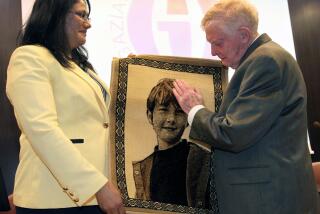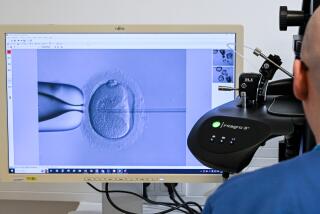Brain-Defective Baby : Source of New Heart Ignites Ethics Debate
When doctors at Loma Linda University Medical Center implanted a new heart in the chest of newborn Baby Paul Holc last month, the operation was considered historic.
Only hours after his birth by Caesarean section, Baby Paul became the youngest-ever heart transplant recipient--and is now listed in good condition. In the medical community, however, his age has attracted less attention than the source of the new heart.
That heart was taken from the body of an anencephalic infant--a baby born with most of her brain missing.
Doctors believe it is the first time in North America that an anencephalic infant has been used as an organ donor, even though about 3,500 such babies are born each year, missing the tops of their skulls and the higher-brain centers that control human thought and feelings.
Left with only a tiny brain stem to power their hearts and lungs, such newborns usually die within hours or days of birth.
Could Be a Milestone
Debate over the Baby Paul case could make the operation a milestone in transplant medicine, influencing ethical and legal guidelines for thousands of future-generation infants, according to doctors and medical ethicists.
Doctors say that if they could routinely use anencephalics as organ donors, with parental permission, much of today’s critical shortage of hearts and other organs for infant transplants would disappear. But that raises a number of legal and ethical issues.
Existing laws require doctors to declare a donor brain-dead before removing organs for transplant. Anencephalics, however, die slowly; by the time brain death occurs, vital organs have deteriorated to the point that they are useless for transplant. In the Baby Paul case, doctors avoided this problem by placing the anencephalic donor on a respirator to keep the heart intact as the brain stem weakened and died.
But some critics contend that placing an anencephalic newborn on life support crosses into uncharted ethical territory by artificially prolonging a life, not for the benefit of the patient but for the sole purpose of harvesting organs. Moreover, the prolonged survival of anencephalic babies on respirators may make it more difficult to diagnose when they actually die, creating the prospect that organs could be removed from a living patient.
‘Slippery Slope’
And while some doctors argue that laws should be changed to legalize the use of anencephalic donors before brain death, others say such a move would usher medical science down a “slippery slope” toward declaring other kinds of patients as fit to be transplant donors, including those in long-term comas.
“This case has really opened up the entire issue . . . of using anencephalic donors,” said Dr. Stephen Ashwal, a Loma Linda neurologist who was a member of the transplant team, led by pioneering infant heart surgeon Dr. Leonard Bailey. “It’s been estimated there probably are about 3,500 anencephalics born every year, and there are probably an equal number of children with severe kidney disease, liver disease or heart disease that could benefit from those organs.
“But there’s obviously a tremendous amount of medical, ethical, religious, moral and political sensitivity to this problem. There is a feeling that somehow . . . we need to review this whole ethical-philosophical question and try to come to terms with it.”
Loma Linda officials have scheduled a symposium today to take a closer look at the issue. The conference--entitled, “Anencephalic Organ Donors: Ethical Breakthrough or Breakdown?”--is expected to draw scores of ethicists and doctors. Bailey is scheduled to be a panelist.
At the core of the controversy, doctors say, are today’s laws governing brain death, which set clearly defined conditions that must be met before body parts are removed. Brain death is defined as the complete loss of brain function and is diagnosed by the absence of basic reflexes such as respiration, pain response and pupil sensitivity to light--functions housed within the brain stem.
Doctors in the Baby Paul case say they went to great lengths to meet the requirements for brain death.
The donor, a Canadian-born girl named Gabrielle, was was placed on a respirator 16 hours after birth as her brain stem began to fail, according to Dr. Tim Frewen, director of the pediatric critical care unit at Children’s Hospital in London, Ontario, Canada, where the case began.
At 48 hours, when Gabrielle no longer responded to skin pressure or light, the respirator was briefly turned off and breathing-reflex tests were conducted, Frewen said. When Baby Gabrielle failed to breathe despite excessive levels of carbon dioxide in her blood, she was declared brain dead.
Eight hours later, a second such test also showed brain death, Frewen said. At that point the tiny body--breathing again on the respirator--was flown to Loma Linda, where Baby Paul was soon to be born with hypoplastic left heart syndrome, an invariably fatal condition in which the heart cannot pump enough blood.
“This infant was, in a sense, a landmark case,” Frewen said of the donor, “because it was the first time that I’m aware of that life support was offered to an infant in which there was no hope the infant would survive.”
‘You Are on Thin Ice’
Immediately, ethicists began to question what had been done.
“Once you start hooking up a live human being for purposes of saving a second party, you are on thin ice . . . in terms of ethics,” said Jim Walters, an ethicist at Loma Linda University’s Center for Christian Bioethics. “These are all very interesting ideas--but the legality of it and the ethics of it are questions. We’re at a frontier here where there hasn’t been broad discussion and certainly no consensus.”
Other ethicists praised doctors for trying to meet brain-death laws, but pointed to a raft of different, more pragmatic problems that now confront medical science.
“There’s the question: What if the (intended) organ recipient dies?” said Arthur Caplan, director of the Center for Biomedical Ethics at the University of Minnesota in Minneapolis. “Do we say too bad and shut off (the respirator)? Or do we keep the baby on the respirator until there’s another recipient? Are we going to ship this little body around to 10 states? Or 20 states?
“You might transform a human being . . . into nothing more than a portable organ farm.”
Caplan suggested doctors and ethicists may have to settle on time limits for keeping such bodies on respirators, turning off the respirator when time expires.
Her Parents Insisted
Other doctors worry about a different scenario: What might have happened if Baby Gabrielle was placed on a respirator and her tiny brain stem stopped weakening. In such a case, doctors might be left with a living, virtually brainless respirator patient, unable to harvest transplant organs, according to Loma Linda neurologist Ashwal.
“If you took 10 or 100 anencephalic infants and maintained them on life-support systems, what percentage of them would ultimately become brain-dead?” Ashwal wondered. “Maybe only 20% or 30% would ultimately become brain-dead if you put them on a respirator. So you’re in a situation where a child with a very severe malformation--who has no prognosis for any kind of meaningful life--is on a ventilator.
“I think medically, neurologically, no one has ever studied this.”
Frewen said doctors elected to try Gabrielle as a donor only because of her parents’ strong insistence. The parents, deeply religious, were aware of their unborn baby’s condition.
“Abortion was not an option for these parents,” Frewen said. “This mother labored away and knew, in the long run, she was not going to give birth to a baby who was going to survive. Their feeling was, this (transplant) was the best possible outcome of what was otherwise a very tragic circumstance.”
Gabrielle’s parents could have decided to turn off the respirator at any time, he said, regardless of how that decision might have affected the fate of Baby Paul.
‘Other Side of Coin’
Such a position, however, raises a larger question in the minds of medical ethicists: Whose rights are more important, those of the anencephalic baby and its parents or those of the organ recipient and its parents?
Ashwal, who now monitors Baby Paul’s recovery, said he is one of many doctors who hope to liberalize today’s laws, enabling anencephalics to be used as donors even when they have not reached brain death. Proponents of such change say it would offer a chance at life for thousands of infants who now die because of the shortage of organs, even though it would take away fundamental human rights from the anencephalic child.
“We see the other side of the coin,” Ashwal said. “We see the children with the hypoplastic hearts who are dying. And other doctors see the kids with the irreversible liver or renal disease. And we know these kids can be helped tremendously by appropriate organ donation.
“And then we see these other infants with this severe, gross malformation of the brain who die--and our obvious conclusion is, we should think about changing the law. . . .”
The debate, which has increased as organ transplants have become more common, may gain new momentum because of the Baby Paul case, several experts predicted. Ethicist Caplan said it took years for society to fully accept the recovery of organs from brain-dead accident victims whose bodies were kept functioning on respirators.
The next step, he said, may be to permit the recovery of organs from anencephalics without resorting to respirators.
‘Storm of Opposition’
“I personally don’t believe we should have to go through the charade of replacing natural respiration and heart beat with something mechanical,” Caplan said. “What difference does it make if the (baby’s) heartbeat and respiration are supplied by the respirator or its own little brain stem?”
However, doctors and ethicists have been extremely reluctant to take the step advocated by Caplan. More than a year ago, state Sen. Milton Marks (D-San Francisco) introduced a bill to amend the standard definition of brain death in California to include babies born with anencephaly.
That legislation, prompted by publicity over the rejection of an anencephalic donor in San Francisco, failed amid “a storm of opposition,” said Juli Winesuff, a consultant to the Senate Subcommittee on the Rights of the Disabled. The bill has since been watered down into a proposal for studying the issue, Winesuff said.
“After studying this issue, I don’t think we’re ready as a society to accept this,” Winesuff said. “It’s heartbreaking sometimes, when you see the parents (of potential organ recipients), and what they go through.”
Doctors say the problem with redefining death is that it blurs what is now a clearly understood and accepted boundary line. If anencephalics are deemed to be dead, despite the operation of brain-stem functions such as pulse and respiration, doctors may be one step nearer accepting other kinds of patients as legally dead, including long-term coma patients or victims of less severe brain malformations--even severe mental retardation, one doctor said.
Where would it stop?
‘Separate Category’
“At some basic level, we (have to) continue to regard the carrying out of basic bodily functions as something that makes us alive,” said USC’s Alexander Morgan Capron, who has spent 20 years studying medical-ethical questions.
Some doctors, like Ashwal, prefer creating a “separate category” for organ donation by anencephalics and maintaining the current definition of death in other cases.
But even that approach has drawn fire from critics.
“There is a great debate about the humanity of anencephalic infants because they do not have the thinking part of the brain . . . what is thought of sometimes as the seed of the soul,” Frewen said.
“However, for the parents of the anencephalic infant--for this family (of Gabrielle)--that was their daughter. She was very real. That mother went through 43 weeks of having this infant moving in her womb. To then have an attitude . . . that this infant never existed, I believe carries its own ethical problems.”
Times medical writer Robert Steinbrook contributed to this story.






